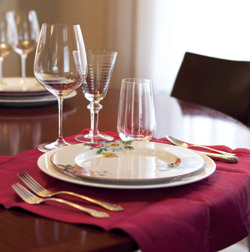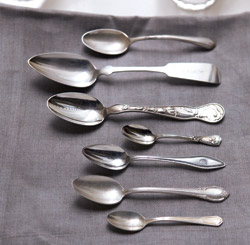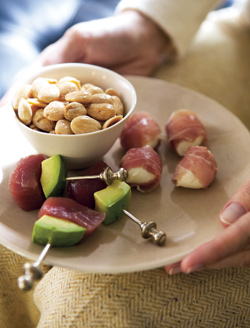The Beautiful Table
A beautiful table means much more than expensive china and sparkling crystal. The table is the stage for a daily gathering. At its most basic, our tables provide a place for the family to meet and talk about the day’s events, plan ahead and catch up with one another. At its most elaborate, the set table is a celebration of holidays and life events. Seated dinner at a gala event or a dear friend’s wedding become reflections of personal taste, whether extravagant or simple, and help us toast to happiness and abundance.
While some of us may feel nervous about setting the table correctly, a glimpse through modern books and magazines on entertaining shows that while the basic placement of knife and fork may still matter, pretty much anything goes these days.
Perhaps we need reminding, by way of our dishes and flatware, that good food, family and friends are an everyday extravagance. Toasting to good health or perhaps saying grace around our tables, humble or elegant, and sharing a meal with one another shows gratitude and a measure of respect.
Traditional family gatherings at a holiday table urge us to reflect on the stories of our past and look forward to a hopeful future. Not only does the table provide a forum for teaching young ones and remembering tradition, but it also shows our families that we hold each other—as well as our history—dear.
The correct stemware is important at an oenophile’s table. Riedel tasting stems provide the perfectly sized and shaped vessels for specific varietals. Stemless Riedel glasses are great for serving water and also cocktails. It doesn’t matter if you have 12 sets of every piece in your silver pattern. Start collecting pieces that speak to you and mix them up. Whether it is a Tiffany pattern from your wedding registry, a piece of coin silver or a vintage spoon from a Paris hotel, each shape and style add interest to the table. Entertaining guru Rebecca Lang mixes Cava with ginger and mint for a refreshing and festive cocktail.

How it’s done: A conversation with Entertaining Pro Rebecca Lang
Even the most casual dinner is special when folks gather together at the table. Your table is a reflection of your personal style, whether that means white plates and simple napkins, holiday china with a festive centerpiece, or the all-out pressed linens, heirloom silver, cut-crystal extravaganza. The ritual of “dressing the table” shows you care to make that table a welcome celebration. It is a very civilized thing to do.
Entertaining comes easy to Rebecca Lang, author of Southern Entertaining for a New Generation (Cumberland House, 2004). Rebecca has spent the last several years working as an author, cooking instructor and speaker. She shares some thoughts on the significance of setting a beautiful table:
AH&L: Why do you think it is important to set the table?
RL: Setting the table is a way to show enthusiasm for a meal with friends. It takes some effort and planning ahead, and guests usually understand and appreciate that. When a table is set for service it also helps the meal to flow more smoothly because everything is ready at each place beforehand.
AH&L: Do you always set the table completely, even if you’re hosting a very casual gathering?
RL: I don’t always set the table. I do for smaller or more formal dinners, but I love to set out a stack of plates and let everyone go through a “buffet” on the bar in our kitchen. If I do the buffet, I have wine, water and linens on the table already. If I set the table, I still love to serve family style. I think it’s honest entertaining. I like to have everyone relaxed at the table, and passing food is one way to do that.
AH&L: What are your thoughts on mixing china, silver and crystal patterns?
RL: It’s practical and fun. Many people don’t have enough of one pattern to use at every place. Mixing is a great way to make the setting more whimsical and personal. It’s also a great way to encourage conversation since guests usually ask about the different pieces. I tend to buy more white plates than anything else, so if I mix in color, white provides a neutral base. The white plates encourage mixing and urge me to use color in other ways.
AH&L: Do you have pieces that you use for sentimental reasons?
RL: I have several of my great aunt’s silver trays that I love to use, and I use my grandmother’s silver-plate and my other grandmother’s china. I think of old tabletop pieces the same way I think about heirloom furniture. My dining room table came from my grandmother, and she ate at that table every day when she was growing up. I think about that as I sit at that table, especially now that I have my own family.
AH&L: Why do you think it is important for a hostess to show personal style at the table?
RL: Well, if you are not showing something of your own style when you entertain, you might as well go out to eat. For guests, being invited to someone’s home is such a pleasure, and showing some personality at the table, whether through the food or décor, is what folks love to see from a hostess.
Rebecca Lang contributes regularly to Edible Atlanta Magazine, Flavors Magazine and Athens Magazine. She received a culinary arts degree from Johnson and Wales University and travels the country speaking on food and entertaining.
Lang is the author of two books, Southern Entertaining for a New Generation (Cumberland House, 2004) and Mary Mac’s Tea Room (Looking Glass Books, 2005). Lang also teaches at the Cook’s Warehouse (cookswarehouse.com) and Salud! Cooking School at Whole Foods Market (wholefoods.com). To visit Lang’s Web site, go to rebeccalangcooks.com.
Angie Mosier on…
Teaching Children to Set the Table
One of the first mealtime rituals that a child usually learns is setting the table. Whether putting out the everyday dinnerware or breaking out the fancy china and silver during the holidays, the practice reinforces the idea that something special is about to happen.
Children love the privilege of being trusted to either follow an adult around the table placing, perhaps, just the iced tea spoon in its proper place, or for older children, being put in charge of the entire task. It is a job that builds upon itself and teaches as it goes. Smaller children learn shapes and placement. They also begin to understand that the table setting translates to respect—respect for the diner but also respect for the cook and the food that will be placed upon the plate.
The task requires thought and planning—what are we eating and how many forks should be put down? How many courses will there be? Do we need soup spoons? Collaboration between the kitchen and the dining room is very important, and each job plays off of the other.
There is also room for creative thinking. Once a child knows the basics, such as forks on the left of the plate, knife and spoon to the right, liberties can be taken with decisions such as what color napkin will be used and how it should be folded.
Perhaps you give a child full creative power over what plates to put out—allow him to mix and match as he chooses. The practice will help your children be a part of the meal and encourages creative thought. When using family heirlooms, children are taught to regard the piece itself, but it also ensures that the memory of the previous owner lives on. Be sure to tell the story of “Great Aunt Mary” or “Grandma Rose” because the telling and re-telling of their history is more valuable than the silver itself. Setting the table may be one of the most practical, yet richest lessons a child can learn.










